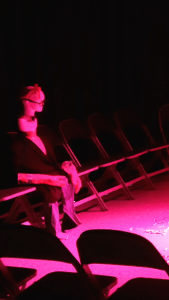The mannequins have appeared to taken a life of their own and now my own personal sanity seems to have been restored. This talk of me trying to be in love and become a mannequin is something that Tadeusz Kantor, a polish painter, theatre director and set designer. Kantor spoke about how the mannequin in his theatre must become a model which passes a strong sense of death and the conditions of the dead (Romanska, 2012, P.265) The mannequins used in Lovefool are objects, yet they are resembling human bodies. The mannequins are a non-being yet they have the appearance as the audience and actor. By me dressing up the main mannequins this me then actually giving it a life and an actual identity? By covering the bare body of the mannequin have I turn given it essence?
There the mannequin sits, as he is dressed and watching me perform. The mannequin has embodied the image of man, and is playing the part of a audience member, as well as a effigy of the embodiment of every bad relationship I have ever had. I find myself questioning what the audience will thing of a head and torso connected adorned with a blazer, trousers, washing up gloves, glasses and a bandana all bound together with sellotape and the hope that none of it will fall off mid performance. If the mannequins has been given an identity then surely this aspect of “solo” has been diminished but this new actor?
This “death” that is brought on by the mannequins is relatable to almost celebrate the death of love. And here my relationship. And now with the mannequin dress it becomes a symbol of both life and death, the life being shown on the outside but the hollow shell inside void with anything inside.
WORKS CITED:
Romanska, M. (2012). The post-traumatic theatre of Grotowski and Kantor. London: Anthem Press, P.265

